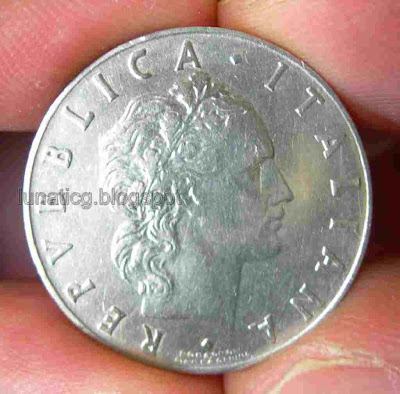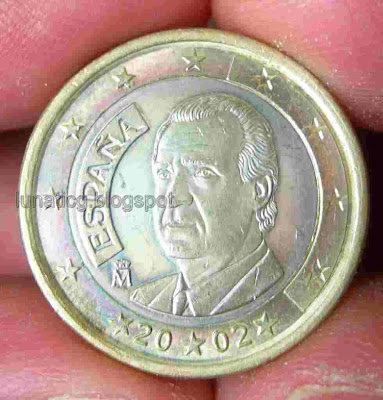Today Kids Project will be faces on coins. To anyone who is new to my blog, Kids Project is a suggestion from me, the best and cheap way to start collecting coin for your kids. This coin hunting project will only cost around 50 to 100 ringgit and you don't need to start with a big budget. You can give them a small budget every month and go out together for their coin hunting trip. You do not have to start with any budget at all with some of my Kids project. Most of them is a circulation coin that you can find in your pocket. There are many famous faces on coins but some of the portraits or faces, we don't even know. Who's faces is that? With a little help from the Internet, we can find information that can help your kids identify who's faces is on that coin.
This is the Swiss Confederation (Confoederatio Helvetica in Latin) or most people called Switzerland. The name is a derivation of the ethnonym Helvetii, the name of the Gaulish tribe inhabiting the Swiss Plateau prior to the Roman conquest. The English name Switzerland is a compound containing Switzer, an obsolete term for the Swiss, in use during the 16th to 19th centuries. The coinage of Switzerland has been struck at the Bern Mint since 1853 with but a few exceptions. This is Confoederatio Helvetica 5 rappen 1906 coin. It weight at 2g, with diameter of 17.1 mm and made of copper-nickel. On the obverse is a crowned head right and on reverse value within wreath.
On the coin is the Libertas head (often interpreted as Helvetia). Libertas (Latin for Liberty) was the Roman goddess and embodiment of liberty. Libertas, along with other Roman goddesses, has served as the inspiration for many modern-day symbols, including the Statue of Liberty on Liberty Island in the United States of America. Helvetia is the female national personification of Switzerland, officially Confœderatio Helvetica, the "Helvetic Confederation". Helvetia appears in patriotic and political artwork in the context of the construction of a national history and identity in the early 19th century, after the disintegration of the Napoleonic Helvetic Republic, with a 1672 play by Johann Caspar Weissenbach. Helvetia appears on official federal coins and stamps from the foundation of Switzerland as a federal state in 1848.
This is Italy 50 lire coin. It weight at 6.25g, made of Stainless Steel and 24.8 mm in diameter. On the obverse is head facing right and on the reverse is vulcan standing at anvil facing left divides date and value. The head on the coin is head of ceres. Ceres is the goddess of growing plants (particularly cereals) and of motherly relationships in Roman mythology. Ceres was worshipped in Ancient Roman religion, and is today again worshipped in Roman Neopaganism. Ceres was usually equated with the Greek goddess Demeter. Her name may derive from the hypothetical Proto-Indo-European root "ker", meaning "to grow", which is also the root for the words "create" and "increase". "Ceres" and "cereal" are cognates. Ceres made up a trinity with Liber and Libera, who were two other agricultural gods. She also had twelve minor gods who assisted her, and were in charge of specific aspects of farming.
Ceres was the daughter of Saturn and Ops, sister of Jupiter, mother of Proserpina by Jupiter and sister of Juno, Vesta, Neptune and Pluto. Works of art depicted Ceres conventionally with a scepter, a basket of flowers and fruit, and a garland made of corn ears (note that "corn" in this instance refers to wheat, barley, or some other old world food grain, not to the new world food grain maize, which is called "corn" in the United States and some other areas of the Western hemisphere). Ceres was also patron of Enna, Sicily. According to legend, she begged Jupiter that Sicily be placed in the heavens. The result, because the island is triangular in shape, was the constellation Triangulum, an early name of which was Sicilia.
This Spain euro coins are made of two alloys; the inner part is made of copper nickel and nickel brass from the outside. They have a diameter of 23.25 mm, thickness 2.33 mm and a mass of 7.55 g. The edge of the coin is alternately smooth and finely milled (3 segments smooth, milled 3 segments). On the obverse is the face of King Juan Carlos I. King Juan Carlos I of Spain born 5 January 1938, is the reigning King of Spain. King Juan Carlos married Sophia of Greece and Denmark in 1962. The couple has three children and eight grandchildren. King Juan Carlos successfully oversaw the transition of Spain from dictatorship to parliamentary democracy.
King Juan Carlos I is a direct descendant of many famous European rulers from different countries. He is a descendant of Queen Victoria of the United Kingdom through his grandmother, Victoria Eugenie; of Louis XIV of France through the House of Bourbon; of the Emperor Charles V, who belonged to the Habsburg dynasty of the Holy Roman Empire; and of the House of Savoy of Italy. The Capetian dynasty to which he belongs is the oldest in Europe. Some of his distant ancestors include Joan, Duchess of Burgundy and queen consort of Philip VI of France, and Lorenzo de' Medici, the Florentine statesman better known as "Lorenzo the Magnificent" (Lorenzo il Magnifico). He is a descendant of Maria Leszczyńska, Queen Consort of France through an unbroken line of Bourbon princesses who married within the Bourbon house.
This is Philippines 1 Piso coin. The coin diameter is 28.9 mm, thickness 2.33 mm, a mass of 9.50 g and made of copper nickel.On the obverse is head of Jose Rizal and on the reverseis tamaraw bull. José Protasio Rizal Mercado y Alonso Realonda (June 19, 1861 – December 30, 1896, Bagumbayan), was a Filipino polymath, nationalist and the most prominent advocate for reforms in the Philippines during the Spanish colonial era. He is considered the Philippines' national hero and the anniversary of Rizal's death is commemorated as a Philippine holiday called Rizal Day. Rizal's 1896 military trial and execution made him a martyr of the Philippine Revolution.
The seventh of eleven children born to a wealthy family in the town of Calamba, Laguna, Rizal attended the Ateneo Municipal de Manila, earning a Bachelor of Arts. Rizal was a polyglot conversant in at least ten languages. Jose Rizal was the founder of La Liga Filipina, a civic organization that subsequently gave birth to the Katipunan led by Andrés Bonifacio and Emilio Aguinaldo. He was a proponent of institutional reforms by peaceful means rather than by violent revolution. The general consensus among Rizal scholars, however, attributed his martyred death as the catalyst that precipitated the Philippine Revolution.
You can start a coin album faces on coin for your kids or even if you are teacher in a classroom, make activity involving coins. Asked them to make a blog about their coin collection and information that they find about that particular coin. Coin is a good hobby, it is "a hobby of King". How about you? Have you start any project with your kids lately? Is that kids project involve any coin or banknote collecting? Feel free to share them with everyone in here.
Source: Wikipedia




